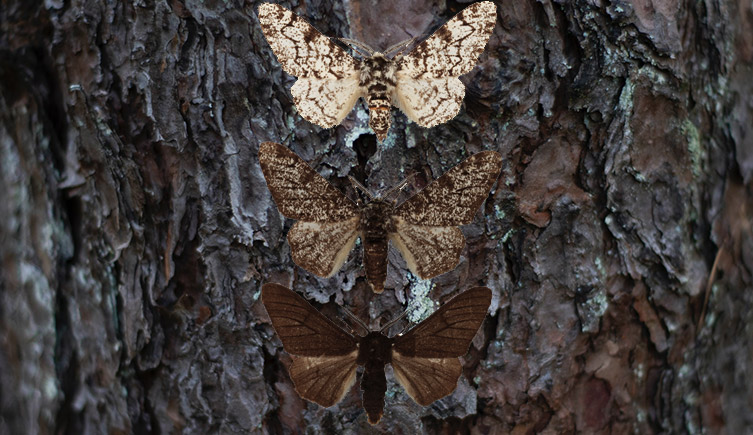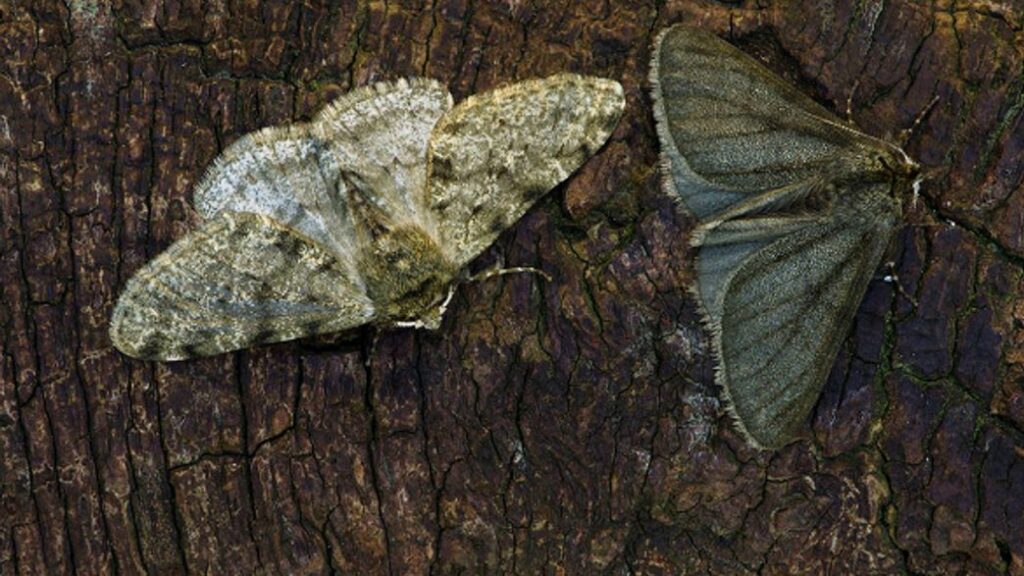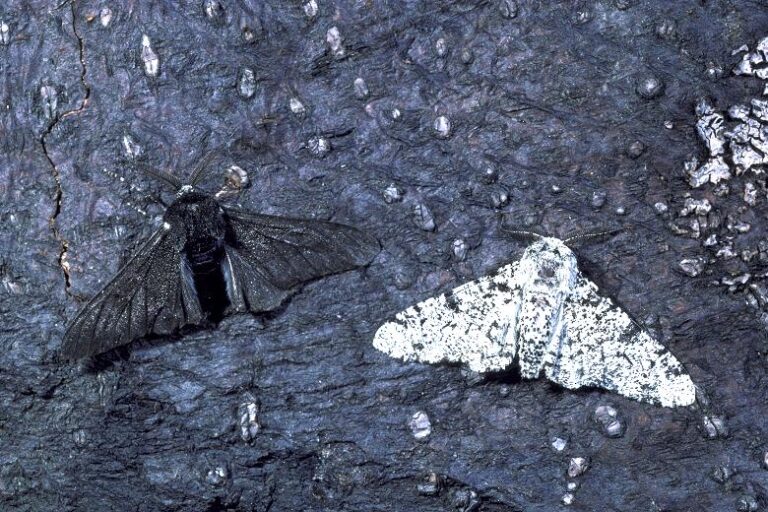The dark Carbonaria peppered moths are often called the “melanic” form. These moths can be black in color. There are two main types of peppered moths: one that is light-colored, and the other that is dark like the Carbonaria moths.
Pollution and factories have made the dark moths more common in places with lots of pollution because they blend in better with dirty tree trunks. This is an example of how animals can change over time to fit their environment better.
How did Carbonaria moth discovery impact evolution?
Carbonaria moths, scientifically known as Biston betularia carbonaria, were first discovered and documented in the 19th century during the early days of entomology.
The discovery of these moths is often attributed to English naturalists and lepidopterists who were keenly observing and cataloging the insect fauna of their region.
Initial Observations: The initial observations of Carbonaria moths revealed a striking contrast in coloration when compared to their closely related counterparts, the typica form of the peppered moth (Biston betularia betularia).
While the typical form displayed a light-colored, speckled appearance, Carbonaria moths were predominantly dark with minimal speckling.
Significance: The discovery of these moths had a significant impact on the field of evolutionary biology.
Moreover, they served as a remarkable example of natural selection in action, as they became central to studies on adaptation and the influence of environmental changes on species’ characteristics.
Evolutionary Significance of Their Coloration

The coloration of Carbonaria moths holds profound evolutionary significance, shedding light on several key aspects of evolutionary biology:
Camouflage and Predation: The ancestral light-colored form of peppered moths (typica) was well-suited for blending into lichen-covered tree bark, offering camouflage from predators such as birds.
However, with the rise of industrialization and pollution, the darker Carbonaria moths gained a survival advantage in urban environments where soot and pollution darkened the trees.
Selective Pressures: The stark difference in coloration between the two forms is a result of selective pressures driven by changes in the environment.
This example, often referred to as “industrial melanism,” demonstrated that heritable traits could be favored or disfavored based on their adaptability to altered habitats.
Adaptive Evolution: Carbonaria moths illustrate how rapid evolutionary changes can occur in response to human-induced environmental alterations.
Furthermore, this phenomenon reinforced the concept of adaptation through natural selection proposed by Charles Darwin.
Role of Industrial Revolution in Their Color Change
The Industrial Revolution, which began in the late 18th century and continued into the 19th century, played a pivotal role in the color change of Carbonaria moths:
Air Pollution: The rapid industrialization during this period led to significant air pollution, particularly in urban areas. Factories burned coal, releasing soot and pollutants into the atmosphere, which coated trees and surfaces in cities with dark particulate matter.
Tree Bark Darkening: As the pollution settled on trees and buildings, it caused a dramatic darkening of the environment. Light-colored moths, such as the typical form, became highly visible and vulnerable to predation against the darkened backgrounds.
Selective Advantage: Carbonaria moths, with their dark coloration, had a selective advantage in polluted urban environments.
Additionally, they were less conspicuous to predatory birds and had a higher survival rate, leading to an increase in their frequency in the moth population.
Iconic Example: The case of the peppered moths, specifically the shift from typica to Carbonaria forms, became one of the most iconic examples of natural selection in response to human-induced environmental changes, highlighting the dynamic relationship between industrialization and biodiversity.
What influences their coloration?
Carbonaria moths continue to provide valuable insights into the interplay between genetics, environmental change, and adaptation in the natural world.
Description of the Typical Coloration
Prevalence of Black and White Coloration: The typical coloration of the peppered moth, known as the typica form (Biston betularia betularia), is characterized by a mottled appearance of light gray or cream-colored wings with black speckling.
In addition, this speckled pattern serves as effective camouflage against lichen-covered tree bark, which was prevalent in unpolluted woodlands.
Melanism in Carbonaria Moths: In contrast, Carbonaria moths (Biston betularia carbonaria) exhibit a strikingly different coloration, characterized by dark, nearly black wings with minimal or no white speckling.
Furthermore, this melanistic coloration is the result of a genetic mutation that causes increased production of the dark pigment melanin in their wing scales.
Factors Influencing Coloration
Natural Selection and Camouflage: The primary driver of coloration in these moths is natural selection. In unpolluted environments, the typica form’s speckled appearance provided effective camouflage against tree bark, reducing predation risk.
Carbonaria moths, on the other hand, had a selective advantage in polluted areas, where their dark coloration allowed them to blend in with the soot-covered trees.
Genetic Basis of Color Variation: The genetic basis of color variation in these moths was elucidated through research. The dark coloration in Carbonaria moths is primarily governed by a single gene, the melanism gene.
Furthermore, the presence of two dominant alleles for melanism results in the darkest form of Carbonaria moths, while one or no dominant alleles produce lighter forms.
Environmental Factors: Environmental factors, such as the prevalence of pollution, play a crucial role in determining the frequency of these color morphs within moth populations.
Environmental changes, like air pollution from industrialization, can shift the advantage from one color morph to another, leading to shifts in the frequency of typica and Carbonaria forms.
Role of Pollution in Color Change
Peppered Moth Study: The most famous study demonstrating the impact of pollution on moth coloration was conducted by British biologist Bernard Kettlewell in the mid-20th century.
Kettlewell’s experiments involved releasing marked moths into polluted and unpolluted woodlands. His findings showed that birds preyed more heavily on conspicuous moths in polluted areas, favoring the Carbonaria form.
Industrial Melanism: The concept of “industrial melanism” emerged from these studies, describing the evolutionary process by which darker, melanic forms of moths become more prevalent in polluted industrial environments.
Industrial melanism serves as a textbook example of natural selection in action, demonstrating how environmental changes can lead to rapid shifts in the frequency of heritable traits.
Recent Research on the Coloration
Recent research on the coloration of Carbonaria moths has continued to shed light on this classic example of evolution. Some key areas of modern research include:
Genomics: Advances in genomics have allowed scientists to explore the genetic basis of coloration in greater detail, identifying specific genes and genetic pathways involved in melanism.
Molecular Mechanisms: Researchers are investigating the molecular mechanisms behind the expression of melanin-producing genes and how they respond to environmental cues.
Climate Change: As climate change affects habitats and landscapes, scientists are studying how it may influence the distribution and coloration of these moths.
How does color help Carbonaria moths survive?

The coloration of Carbonaria moths is not just a passive trait but is closely tied to their behavior and survival strategies.
Their adaptations, including camouflage and behavioral choices, have allowed them to thrive in different environments and serve as a compelling case study in evolutionary biology.
Camouflage and Predation Avoidance
Camouflage in Carbonaria Moths: The coloration of Carbonaria moths provides them with a form of camouflage in their respective environments. In heavily polluted industrial areas where tree bark was darkened by soot, the dark coloration of Carbonaria moths allowed them to blend in with their surroundings.
Furthermore, this camouflage reduced their visibility to visually hunting predators, primarily birds. As a result, Carbonaria moths faced lower predation rates compared to their lighter-colored typica counterparts.
Predation Avoidance: Predation is a significant selective pressure in the natural world, and the ability to avoid being eaten is crucial for a species’ survival.
Additionally, the adaptation of dark coloration in Carbonaria moths represents a classic example of how natural selection can favor traits that enhance predation avoidance in specific environments.
Behavioral Adaptations Related to Color
Resting Behavior: Carbonaria moths often exhibit behavioral adaptations related to their coloration. They tend to rest on surfaces that match their dark color, such as dark tree trunks or branches, during the day.
By choosing resting spots that offer better camouflage, these moths further reduce the risk of predation.
Activity Patterns: The activity patterns of Carbonaria moths may also be influenced by their coloration.
They are more active at night when their dark coloration is less likely to be a liability, as most predators rely on visual cues.This nocturnal behavior minimizes their exposure to daytime predation.
Mating Behavior: There is evidence to suggest that Carbonaria moths may also exhibit behavioral adaptations related to mate selection. In polluted environments, where
Carbonaria moths are more common, individuals with the same dark coloration are more likely to mate.
This preference for similar coloration may enhance reproductive success in their specific environment.
FAQ’s
What color is typica version of the moths?
The typica version of peppered moths typically has a light gray or cream-colored wing with black speckling.
What is a carbonaria moth?
A Carbonaria moth is a melanistic form of the peppered moth (Biston betularia), characterized by predominantly dark, nearly black wings.
What is Carbonaria?
Carbonaria refers to a specific melanic form of the peppered moth (Biston betularia), known for its dark coloration.
Why are they called Carbonaria moth?
They are called Carbonaria moths due to their dark coloration resembling carbon or soot, a characteristic that distinguishes them from the typical form.
What is the difference between typica and carbonaria peppered moths?
The main difference lies in their coloration. Typica moths are light gray with black speckles, while Carbonaria moths are predominantly dark or black with minimal speckling.
Why do you think dark-colored moths are called Carbonaria?
Dark-colored moths are called Carbonaria because their dark appearance resembles carbon or soot, which is often associated with industrial pollution and urban environments.
Final Words
In conclusion, the study of Carbonaria moths, with their remarkable coloration dynamics, offers a profound window into the world of evolutionary biology and ecological adaptation.
The historical discovery of these moths and their contrasting color forms, typica and Carbonaria, provided early evidence of the power of natural selection in response to changing environments.
The role of industrialization and pollution-induced color change, known as industrial melanism, has become an iconic example of how species can rapidly adapt to human-altered landscapes.
However, controversies and debates persist, with some critics questioning the exclusive role of natural selection and alternative hypotheses proposing the importance of other factors.

